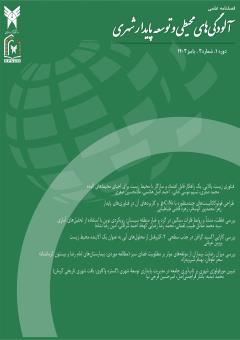فناوری زیست پالایی: یک راهکار قابل اعتماد و سازگار با محیط زیست برای احیای محیطهای آلوده
محورهای موضوعی : راه حل های موثر و قابل توسعه برای کنترل و حذف آلودگی های محیطی
محمد صفری
1
,
نسیم موسی خانی
2
,
احمد اصل هاشمی
3
,
غلامحسین صفری
4
*
![]()
1 - دانشکده پزشکی، دانشگاه آزاد اسلامی واحد کرمان، کرمان، ایران
2 - کمیته تحقیقات دانشجویی، دانشگاه علوم پزشکی تبریز، تبریز، ایران
3 - گروه آموزش بهداشت محیط دانشگاه علوم پزشکی تبریز
4 - گروه مهندسی بهداشت محیط، دانشکده بهداشت، دانشگاه علوم پزشکی تبریز، تبریز، ایران
کلید واژه: آلودگی محیط زیست, میکروارگانیسمها, تجزیه زیستی, زیست پالایی درجا, زیست پالایی دگرجا,
چکیده مقاله :
آلودگی محیطزیست در چندین دهه اخیر به دلیل افزایش فعالیتهای انسانی افزایش یافته است. صنعتیشدن جهانی و روشهای کشاورزی مدرن، به بروز آلایندههایی مانند هیدروکربنها، آفتکشها و فلزات سنگین منجر شده است. فناوری زیستپالایی یک استراتژی کلیدی برای مواجهه با چالشهای متنوع ناشی از آلودگی محیطی است که از توان میکروارگانیسمها برای پاکسازی و حفاظت از اکوسیستمها و حذف آلایندهها از محیطهای آلوده بهره میبرد. زیستپالایی فرآیندی است که شامل کاهش، حذف، تغییر و تبدیل آلایندهها در محیطهای طبیعی نظیر خاک، رسوبات، هوا و آب با استفاده از میکروارگانیسمها، قارچها، گیاهان یا آنزیمهای آنها به منظور بازگرداندن محیط آسیبدیده به شرایط اولیه است. فناوریهای زیستپالایی را میتوان به دو دسته اصلی درجا و دگرجا تقسیمبندی کرد. زیستپالایی درجا به تصفیه آلایندهها در محل آلوده اختصاص دارد، در حالی که زیستپالایی دگرجا شامل جمعآوری و انتقال مواد آلوده به محل دیگری برای تصفیه است. روشهای زیستپالایی درجا شامل تزریق زیستی، تهویه زیستی، تحریک زیستی، مکش زیستی، تقویت زیستی و گیاهپالایی هستند. از طرفی، روشهای دگرجا شامل تصفیه به کمک زمین، کمپوستسازی، تودههای بیولوژیکی، فیلترهای زیستی، راکتورهای زیستی و روش ویندرو میباشند. با وجود مزایای فراوان این فناوری نظیر پایداری، هزینه کم و سازگاری با محیطزیست، زیستپالایی با چالشهای مهمی مانند ویژگیهای بیولوژیکی، تنوع زیستمحیطی، ناهمگونی سایتها، مشکلات مقیاسپذیری و موانع نظارتی روبرو است. برای مواجهه با این چالشها، تحقیق، توسعه و مدیریت چندرشتهای ضروری است. این مقاله یک مرور جامع از زیستپالایی، اهداف، اصول، روشها، عوامل مؤثر، مزایا و چالشهای پیش روی آن و همچنین چشماندازهای آتی این فناوری را ارائه میدهد و بر نیاز به تحقیقات مستمر برای بهینهسازی و گسترش کاربرد آن تأکید میکند.
Environmental pollution has escalated over the past few decades due to the rise in anthropogenic activities. Global industrialization and modern agricultural practices have led to the emergence of pollutants such as hydrocarbons, pesticides, and heavy metals. Bioremediation technology is a key strategy for addressing the diverse challenges posed by environmental pollution, leveraging the capabilities of microorganisms to clean and protect ecosystems and remove contaminants from polluted environments. Bioremediation is a process that involves the reduction, removal, modification, and transformation of pollutants in natural environments such as soil, sediments, air, and water using microorganisms, fungi, plants, or their enzymes in order to restore the damaged environment to its original conditions. Bioremediation technologies are broadly categorized into in-situ and ex-situ methods. In-situ bioremediation is dedicated to the treatment of pollutants at the contaminated site, while ex-situ bioremediation involves the collection and transfer of contaminated materials to another location for treatment. In-situ bioremediation methods include biosparging, bioventing, biostimulation, bioslurping, bioaugmentation, and phytoremediation. On the other hand, ex-situ methods include land farming, composting, biopiles, biofilters, bioreactors, and windrow methods. Despite the numerous advantages of this technology, such as sustainability, low cost, and environmental compatibility, bioremediation faces significant challenges including biological specificity, environmental variability, site heterogeneity, scalability issues, and regulatory barriers. Overcoming these obstacles requires interdisciplinary research, development, and management. This paper provides a comprehensive overview of bioremediation, its goals, principles, methods, influencing factors, benefits, and the challenges it faces, as well as future prospects for this technology, emphasizing the need for ongoing research to optimize and expand its applications.

